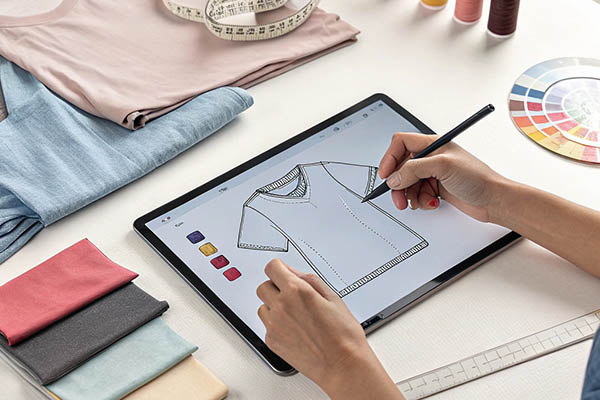Creating a T-shirt from scratch involves multiple steps, from initial design to final production. Whether you’re starting a clothing brand or making custom apparel, understanding the entire process helps ensure a high-quality final product.
The T-shirt manufacturing process includes designing, choosing fabric1, creating patterns2, cutting, sewing, printing or embroidery, quality control, and packaging. Each stage is crucial to achieving a professional and durable product.
A well-planned process ensures the T-shirt meets design expectations, maintains durability, and is cost-effective for production. Let’s go through the step-by-step process.

1. Designing a T-shirt
Every T-shirt starts with a concept. A good design reflects the brand’s identity and ensures the final product is appealing to customers.
The design process includes sketching ideas, choosing colors, selecting fonts or artwork, and determining print placement. Digital design tools like Adobe Illustrator and Canva help create precise mockups.
Factors to consider in T-shirt design
| Factor | Importance |
|---|---|
| Target Audience | Tailor design elements to suit your customers’ preferences and style. |
| Fabric Type | Certain fabrics display colors differently and require specific printing methods. |
| Print Placement | Ensures the artwork is centered and scaled for different shirt sizes. |
| Color Contrast | High contrast helps the design stand out on both light and dark garments. |
Tip: Work in 300 DPI resolution or higher to guarantee sharp, vibrant prints.
2. Choosing the Right Fabric
Fabric selection impacts comfort, durability, and overall print quality. Popular T-shirt materials include 100% cotton, cotton-poly blends, and polyester, each offering unique benefits.
Common T-shirt fabrics
| Fabric Type | Features | Best For |
|---|---|---|
| 100% Cotton | Breathable, soft, absorbs ink well | Casual wear, screen printing |
| Cotton-Poly Blend | Reduced shrinkage, durable | Fashion T-shirts, DTG printing |
| 100% Polyester | Moisture-wicking, lightweight | Sportswear, sublimation printing |
| Tri-Blend (Cot/Poly/Rayon) | Soft, vintage feel, slight stretch | Premium, trendy apparel |
| Organic Cotton | Eco-friendly, chemical-free | Sustainable clothing lines |
Choose a material based on print needs, comfort levels, and budget.
3. Creating a Pattern
A pattern is a blueprint that outlines how fabric is cut into individual pieces for assembly (front, back, sleeves, etc.). Accurate patterns ensure consistent sizing.

- Base Pattern Drafting – Using manual methods or specialized software, create a master template.
- Pattern Grading – Adjust the base pattern for multiple sizes (S, M, L, etc.).
- Output & Verification – Print pattern pieces or use digital cutting tools.
Note: High-quality pattern making ensures uniformity and reduces fabric waste during production.
4. Cutting and Sewing
After patterns are ready, the selected fabric is spread, cut, and prepared for sewing.
Cutting and Sewing Steps
| Step | Description |
|---|---|
| Fabric Spreading | Layers of fabric are laid flat for even cutting. |
| Cutting | Manual or automated machines cut panels following the pattern’s outline. |
| Sorting & Labeling | Panels are organized by size, color, and design. |
| Sewing | Industrial machines (overlock, flatlock, coverstitch) assemble the panels into a finished T-shirt. |
| Quality Inspection | Initial check for stitch consistency, loose threads, or fabric flaws before proceeding to printing or final QC. |
Good stitching ensures seam durability and overall garment longevity.
5. Printing or Embroidery
Customizing T-shirts with logos, text, or artwork is a major step. Various printing methods suit different designs, quantities, and fabrics.
Popular T-shirt Printing Methods
| Method | Best For | Advantages |
|---|---|---|
| Screen Printing | Large orders, solid-color designs | Cost-effective for bulk, long-lasting prints |
| DTG (Direct-to-Garment) | Small runs, full-color or complex artwork | Photorealistic detail, no setup cost for short runs |
| Heat Transfer (DTF/Vinyl) | Personalization, smaller quantities | Ideal for adding names/numbers, easy to apply |
| Sublimation | 100% polyester, all-over prints | Permanent, vibrant colors, no cracking |
Choose the printing method based on design complexity, order volume, and fabric type.
6. Quality Control
After printing or embroidery, quality control (QC) ensures each T-shirt meets specifications. QC prevents defects from reaching customers.

Key QC Checks
| Quality Factor | Inspection Method |
|---|---|
| Stitch Integrity | Inspect seams for skipped stitches or loose threads. |
| Print Alignment | Confirm placement accuracy on the garment. |
| Color Consistency | Compare prints against approved color samples. |
| Sizing & Fit | Verify measurements against the size chart. |
A robust QC process reduces returns and maintains brand reputation.
7. Packaging and Shipping
Once T-shirts pass QC, they are packaged and prepared for distribution. Packaging preserves garment quality and showcases brand identity.
Common Packaging Options
| Packaging Type | Features |
|---|---|
| Poly Bags | Budget-friendly, protects from dust and moisture. |
| Eco-friendly Packaging | Recyclable or biodegradable materials for a sustainable image. |
| Branded Boxes | Premium unboxing experience, suitable for upscale brands. |
Explore eco-friendly packaging3 if aligning with a sustainable brand strategy.
Conclusion
Designing and manufacturing a T-shirt involves clear steps—conceptualization, fabric choice, pattern creation, cutting, sewing, printing4, quality checks5, and finally packaging.
By understanding each phase, brands and apparel creators can streamline production, maintain high standards, and deliver T-shirts that customers will love and trust.
-
Learn about material properties, pros, and cons to find the perfect fabric for your T-shirt needs. ↩
-
Discover advanced digital tools that simplify pattern creation and grading for multiple sizes. ↩
-
Explore sustainable packaging solutions that align with eco-conscious values and brand image. ↩
-
Uncover in-depth comparisons of different printing processes focusing on durability and vibrant results. ↩
-
Dive deeper into the inspection methods and best practices to ensure high-quality garments. ↩













